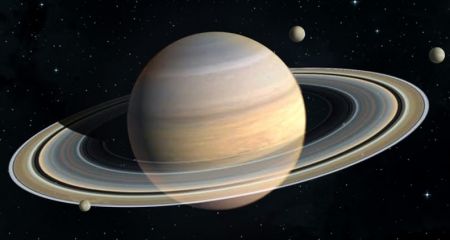Difference between revisions of "Saturn"
Jump to navigation
Jump to search
m |
|||
| Line 1: | Line 1: | ||
| − | + | [[File:Saturn.jpg|thumb|450px|right|Saturn as seen from orbit]] | |
| − | + | '''Saturn''' (also known as '''Sol VI''') is the sixth [[planet]] of the [[Sol system]]. | |
| − | |||
| − | |||
| − | |||
| − | |||
| − | |||
| − | |||
| − | |||
| − | |||
| − | |||
| − | + | It is the second-largest [[planet]] in the [[Sol System]], after [[Jupiter]]. | |
| + | |||
| + | |||
| + | It is well known for its rings, and is known (like [[Jupiter]]) to be orbited by many moons. It was also orbited by navigational control satellites. | ||
| + | * The rings of Saturn generated magnetic distortions, which can make a starship invisible to another starship if the vessel could jump out of warp behind one of the planet's moons. | ||
| + | |||
| + | |||
| + | Star charts classify this planet as [[Planetary Classification Table#J|Class J]]. It was a charter member of the [[United Federation of Planets]] in [[2161]]. | ||
| − | |||
| − | |||
| − | |||
| − | + | By the mid-[[21st Century]], [[Human]]s had established a [[colony]] on Titan, Saturn's largest [[moon]]. | |
| − | |||
| − | + | By the early [[24th century]], a [[shuttle]] route had been established from [[Jupiter]] to Saturn and back, once a day, every day, known as the "Jovian Run." | |
| − | |||
| − | |||
| − | |||
| + | == Astronomical data == | ||
| + | === Location === | ||
| + | * [[Sol System]] (Sector 001) | ||
| − | |||
| − | |||
| + | === Names === | ||
| + | * Sol VI | ||
| + | * Saturn | ||
| − | |||
| − | + | === Moons & Satellites === | |
| + | * Saturn has at least 61 known [[moon]]s in its [[orbit]], and hundreds of particularly small natural [[satellite]]s within its rings.<br> The most prominent moons are: <br> Mimas <br> Enceladus <br> Tethys <br> Dione <br> Rhea <br> Titan <br> Iapetus | ||
| + | * Saturn [[Drydock]] station | ||
| + | * Dozens to hundreds of "moonlets" inside Saturn's rings | ||
<center>{{SolSystem}}</center> | <center>{{SolSystem}}</center> | ||
| + | |||
| + | <br> | ||
| + | |||
| + | [[category:planet]] | ||
Latest revision as of 17:55, 17 May 2022
Saturn (also known as Sol VI) is the sixth planet of the Sol system.
It is the second-largest planet in the Sol System, after Jupiter.
It is well known for its rings, and is known (like Jupiter) to be orbited by many moons. It was also orbited by navigational control satellites.
- The rings of Saturn generated magnetic distortions, which can make a starship invisible to another starship if the vessel could jump out of warp behind one of the planet's moons.
Star charts classify this planet as Class J. It was a charter member of the United Federation of Planets in 2161.
By the mid-21st Century, Humans had established a colony on Titan, Saturn's largest moon.
By the early 24th century, a shuttle route had been established from Jupiter to Saturn and back, once a day, every day, known as the "Jovian Run."
Astronomical data
Location
- Sol System (Sector 001)
Names
- Sol VI
- Saturn
Moons & Satellites
- Saturn has at least 61 known moons in its orbit, and hundreds of particularly small natural satellites within its rings.
The most prominent moons are:
Mimas
Enceladus
Tethys
Dione
Rhea
Titan
Iapetus - Saturn Drydock station
- Dozens to hundreds of "moonlets" inside Saturn's rings
| Planetary bodies in the Sol system |
|---|
| Mercury • Venus • Earth • Mars • Jupiter • Saturn • Uranus • Neptune • Pluto |
